In 2019, 18% of American homes chose transitional design. This style combines classic and modern elements. It’s loved by designers and homeowners for its timeless beauty.
The key to is balance. It mixes traditional warmth with modern minimalism. This creates spaces that are both timeless and trendy.
Transitional style is known for its neutral colors and textures. It also blends old and new furniture. This makes it appealing to many, showing its flexibility and appeal.
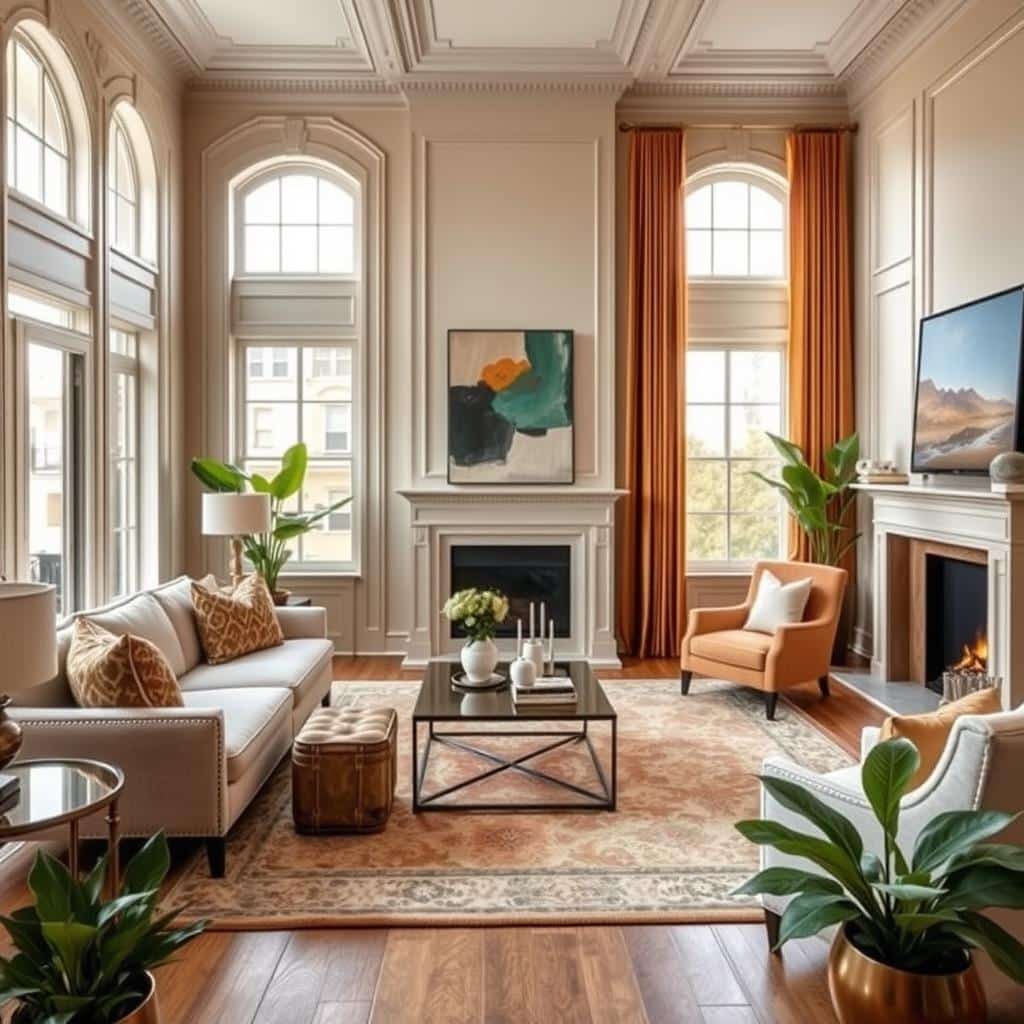
Exploring reveals its core principles and elements. We’ll see why it’s a favorite among homeowners and designers.
Timeless Essence of Transitional Interior Design
Transitional interior design mixes old and new styles beautifully. It creates a look that lasts, loved by many homeowners. At its core, it uses a calm color scheme like beige, taupe, and gray. These colors bring peace and elegance, making the space versatile.
Neutral Palette and Ambient Lighting
Natural light is key in transitional design, making the space bright and open. Table lamps and pendant lights add a soft, cozy light. This mix of light creates a peaceful and welcoming feel, showing the heart of transitional design.
Sophisticated Furniture and Thoughtful Layout
The look of transition interior design is all about smart furniture. It features comfy, stylish sofas and chairs with simple designs and rich textures. The furniture is placed to make the space feel cozy and inviting, often around a fireplace.
The fireplace is a special touch, blending old and new. It has a classic stone surround and a modern firebox. This mix makes the fireplace a standout feature in the room.
| Design Element | Characteristic |
|---|---|
| Color Palette | Neutral tones like beige, taupe, and gray |
| Lighting | Combination of natural light and warm, ambient lighting |
| Furniture | Plush, upholstered pieces with clean lines and textured fabrics |
| Fireplace | Classic stone surround with a modern firebox |
Transitional interior design skillfully combines old and new. It creates a space that is both timeless and welcoming. It’s perfect for those who want a balanced and peaceful home.
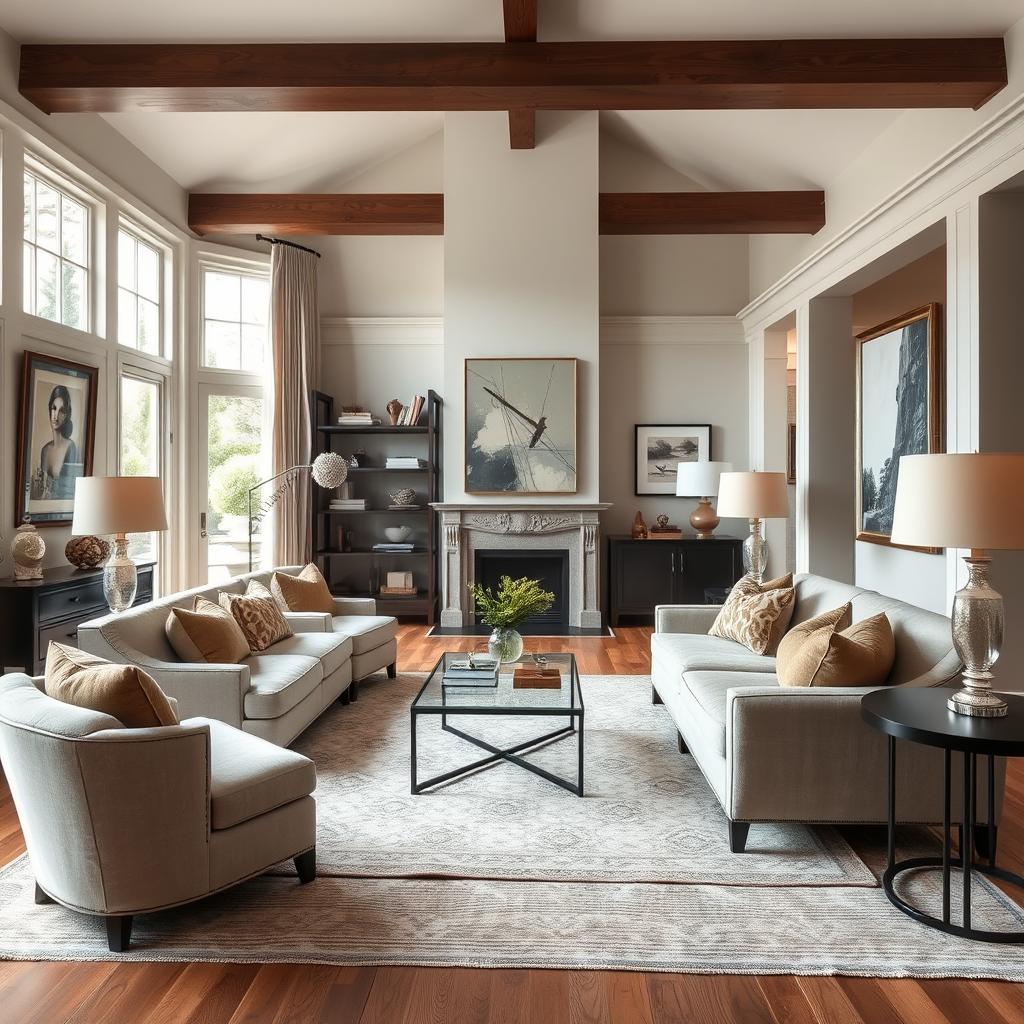
Harmonizing Materials and Textures
Transitional interior design mixes different materials and textures to make a space elegant and welcoming. It’s all about combining various elements. Smooth surfaces meet textured accents for a look that’s both cohesive and eye-catching.
Diverse Material Selection
Transitional design uses a mix of materials, like the smooth stone of a fireplace and the warm wood of shelves and coffee tables. This mix adds depth and interest, making the space balanced and sophisticated.
The Beauty of Wood
Wood is key in transitional interiors, with its natural beauty and unique grains. Wooden pieces, like shelves and coffee tables, ground the room with their timeless charm.
Elegant Metal Accents
Metal accents, like brass or gold, add a modern touch to transitional design. You’ll find them in lamp bases, hardware, or decorative items. They bring a sleek, contemporary elegance to the space.
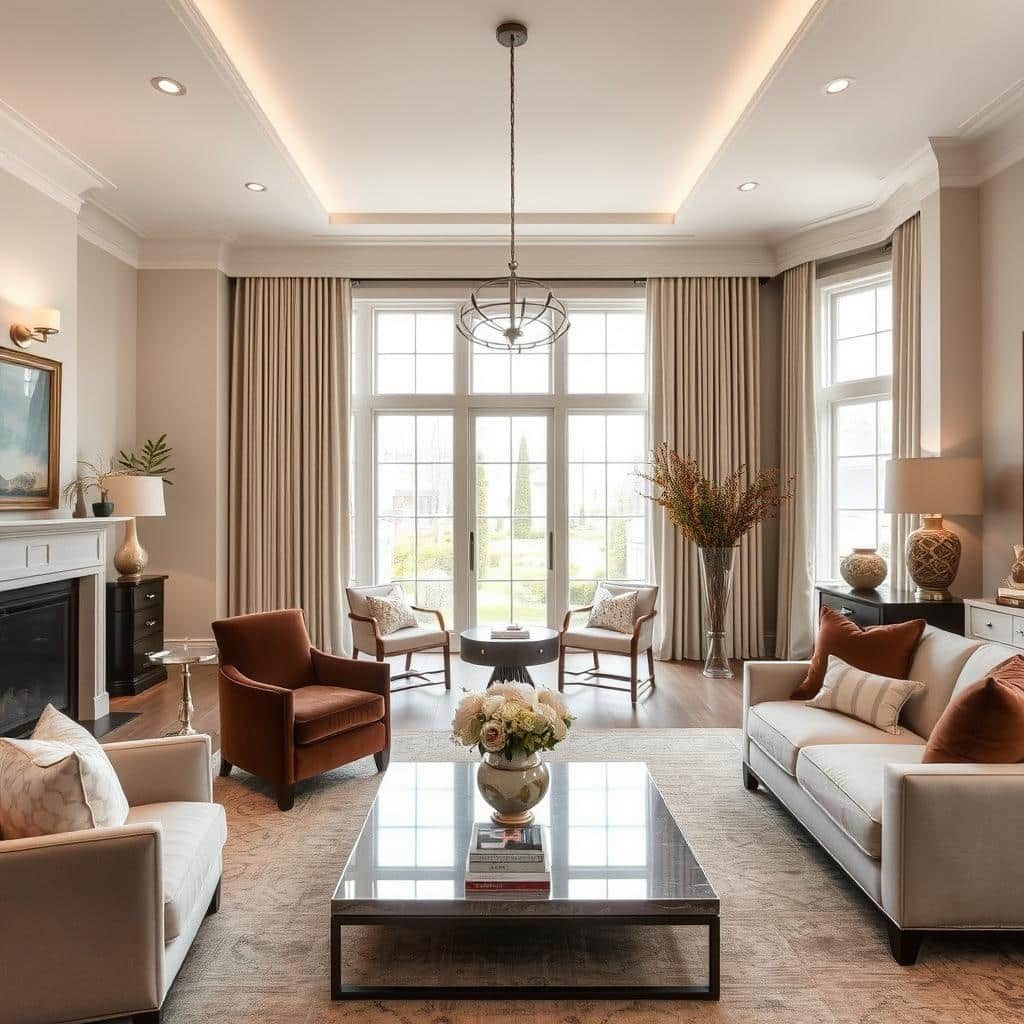
Upholstered furniture, like plush sofas and armchairs, adds comfort and style. Fabrics like chenille or velvet make the space feel luxurious. Area rugs and window drapery add to the space’s visual appeal.
Transitional design skillfully combines different materials and textures. It creates a space that’s both elegant and modern, blending the best of the past and present.
Transitional Interior Design Explained
Transitional interior design mixes traditional and modern elements. It creates a versatile and timeless look. This style blends classic and modern, avoiding strict design categories.
Transitional spaces have a calm, simple look. They use neutral colors and comfortable furniture. Ornate accents add a touch of elegance.
The term “transitional” means mixing different styles. It allows for change and growth. Transitional design starts with traditional elements and adds modern touches.
Transitional spaces often use neutral colors. These include taupes, tans, and creamy vanillas. This creates a soothing atmosphere.
Transitional home decor is great for sustainable living. It combines vintage and modern pieces. This blend of old and new is appealing.
| Key Aspects of Transitional Interior Design | Characteristics |
|---|---|
| Color Palette | Neutral hues like taupes, tans, and creamy vanillas, with a monochromatic composition |
| Furniture | Comfortable, streamlined silhouettes that balance traditional and modern elements |
| Textiles and Textures | Layered, rich, and varied, creating visual interest and depth |
| Accessories | Ornate, statement-making pieces that add sophistication and character |
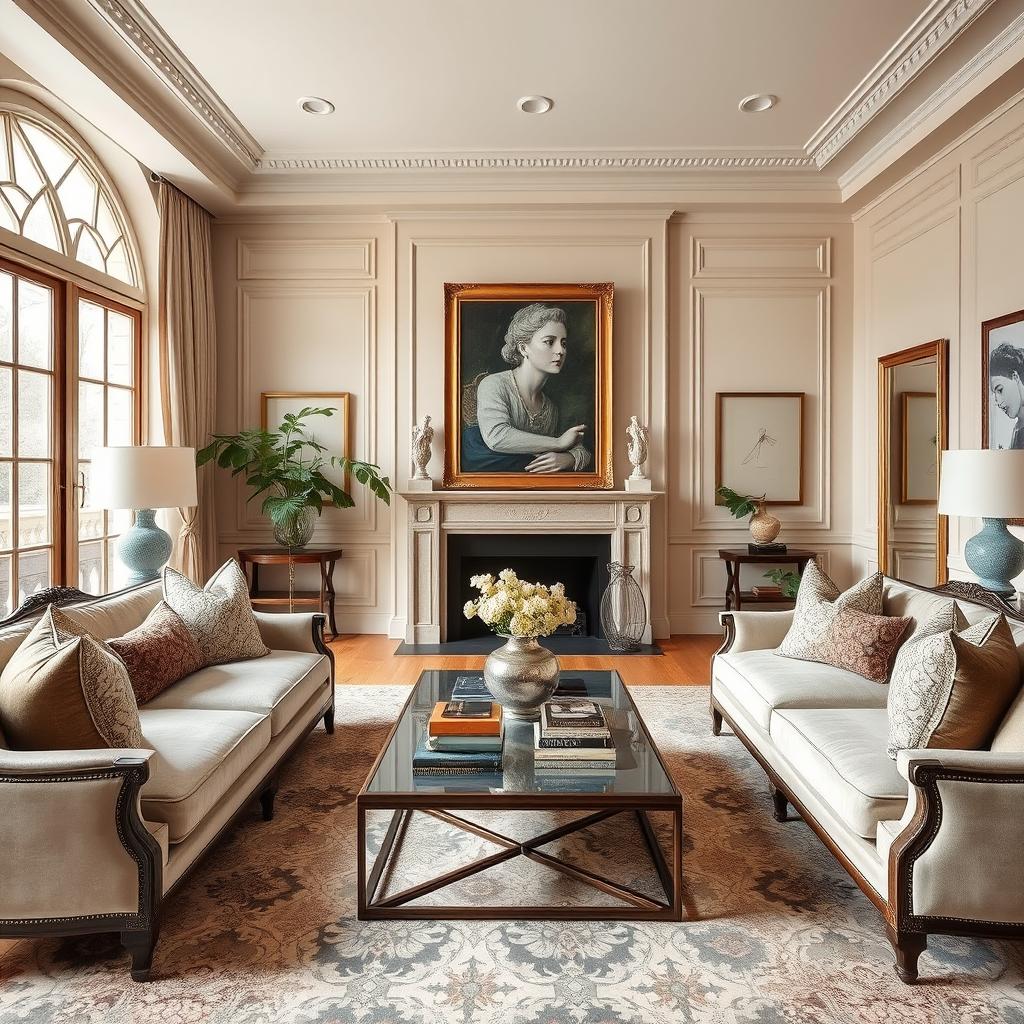
Transitional interior design is flexible and easy to adapt. It lets homeowners mix traditional and modern elements. This creates a harmonious and timeless space that suits personal tastes and changing trends.
Blending Traditional and Contemporary Elements
Transitional interior design is about finding the right mix of old and new. It creates a look that is both elegant and lasting. This style is loved by many because it balances different elements well.
A key part of transitional design is mixing curved furniture with straight lines. This mix adds depth and interest to a room.
Curved Furniture Meets Clean Lines
Spaces with transitional decor often have curved sofas and chairs. These pieces add a soft touch to the room’s straight lines. This mix makes the room visually appealing and balanced.
The curved furniture brings a classic charm. At the same time, the straight lines keep the room feeling modern and sleek.
Layered Textiles and Textures
Textiles and textures are vital in transitional design. They add depth and interest. Velvet on furniture pairs well with satin or linen on throw pillows.
Heavy drapes add a touch of elegance. An area rug with a subtle pattern brings everything together. It makes the room feel cozy and welcoming.
Transitional interior design style is all about combining old and new styles. It creates spaces that are both timeless and trendy. This appeals to a wide range of tastes.

Modern Transitional Interior Design: Achieving Balance
In transitional modern interior design, balance is key. Start with a neutral color palette as the base. Then, mix traditional furniture with modern lines to balance old and new.
Add depth with timeless upholstery and pops of color from accessories. Traditional elements like chandeliers or brass fixtures keep the balance. This blend creates a sophisticated space that’s both timeless and trendy.
Neutral Color Palettes and Textures
Neutral colors are essential in modern transitional interior design. They unite traditional and modern styles. Beige, gray, and white are great for a clean canvas.
Textures like velvet, wood, and rugs add interest and warmth. They balance the formality of traditional design with modern minimalism.
| Element | Traditional Design | Transitional Design |
|---|---|---|
| Color Palette | Rich, jewel-toned hues | Neutral, muted tones |
| Furniture Silhouettes | Ornate, elaborate designs | Clean, streamlined shapes |
| Textiles | Intricate patterns, luxurious fabrics | Subtle patterns, textural weaves |
| Accessories | Ornate, decorative elements | Minimalist, statement-making pieces |
Designers achieve balance by layering elements. This creates modern transitional spaces that are both beautiful and practical. They appeal to many homeowners and design lovers.
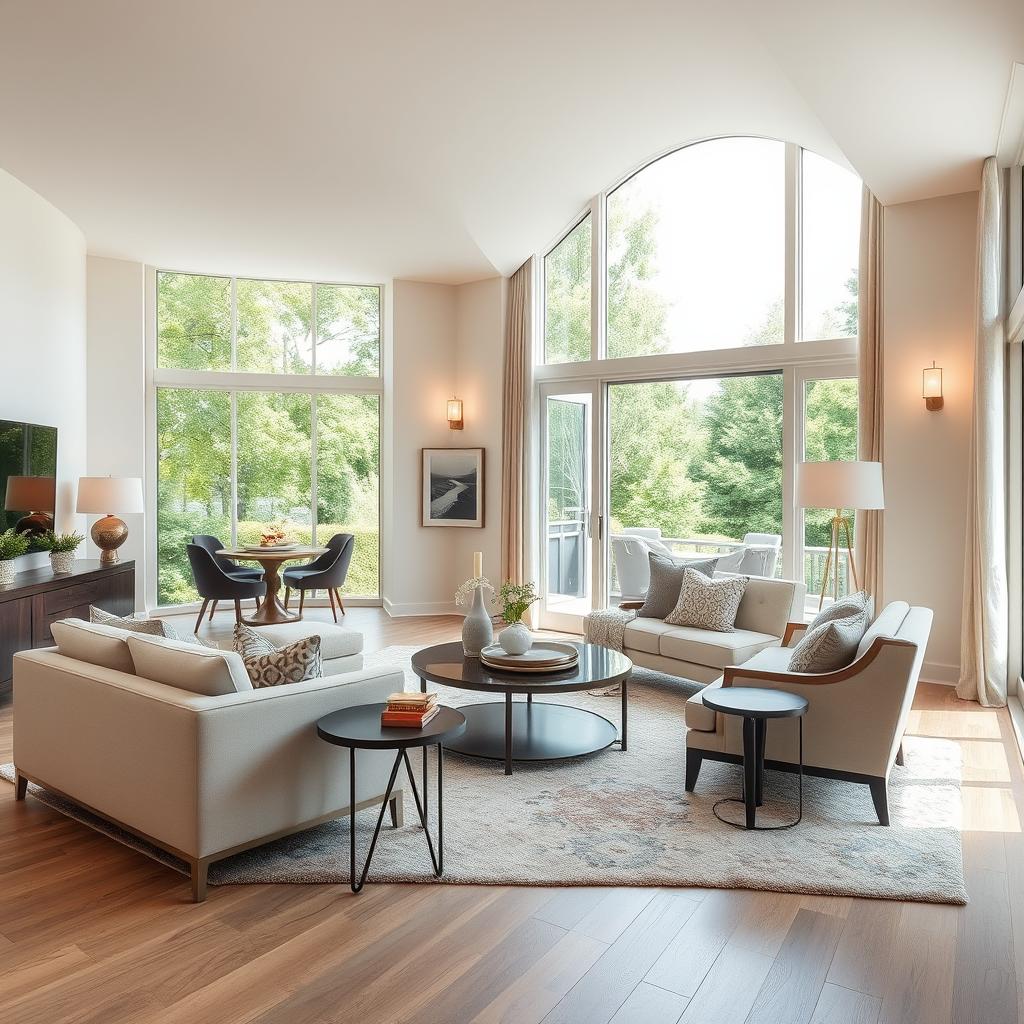
Transitional Design Principles
Transitional design is all about finding a balance between old and new. It mixes classic and modern elements to create spaces that are both timeless and stylish. These interiors blend the warmth of traditional design with the simplicity of modern style.
They use a mix of textures, materials, and colors. This way, old and new elements work together perfectly.
There are a few key principles in transitional design:
- Balance: Transitional spaces find a balance between classic and modern. This ensures no single element takes over.
- Harmony: Choosing the right materials, furnishings, and accessories creates a cohesive look. This makes the space visually appealing.
- Versatility: Transitional design is flexible. It lets homeowners change their space to match their style and preferences over time.
Transitional design helps homeowners create spaces that are both timeless and personal. It blends the old with the new, making each space unique and special.
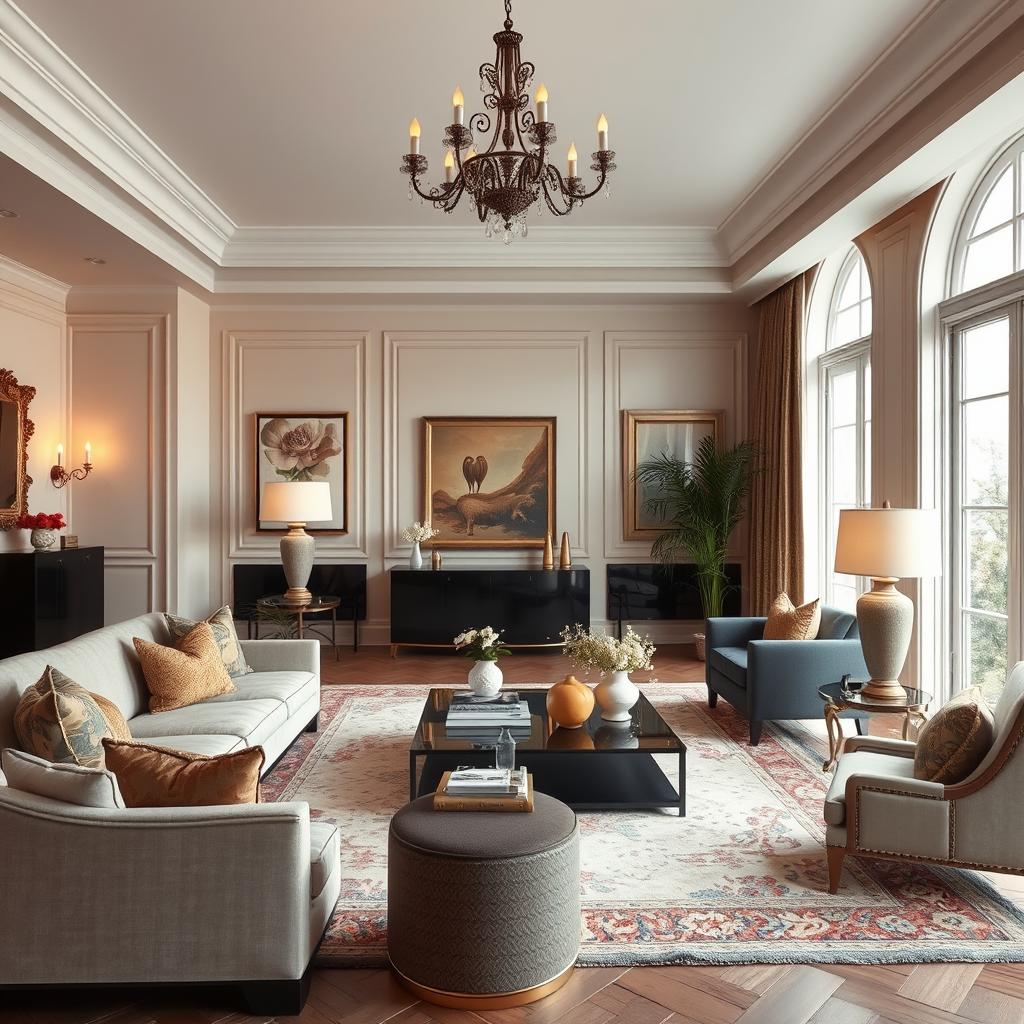
Versatility in Transitional Spaces
Transitional design is known for its flexibility. It lets homeowners easily change the style to fit their tastes and the latest trends. Unlike strict design categories, transitional spaces are adaptable. They can suit many personal tastes and styles.
Adapting to Individual Tastes
The power of transitional interior design is in mixing old and new. It creates a balance that suits different styles. Whether you like classic elegance or modern simplicity, transitional design lets you add your personal touch. This way, your space truly shows your style.
Incorporating Evolving Trends
Transitional design also excels at adding new trends smoothly. It combines lasting elements with modern ones. This keeps your space looking fresh and stylish, without losing its timeless beauty.
This flexibility makes transitional design a great choice. It offers a timeless yet on-trend look. This design can grow with your changing tastes and preferences.
Color Palettes in Transitional Design
Transitional interior design is known for its elegant color schemes. It often starts with a neutral base of beige, taupe, and gray. These colors create a calm background, letting other design elements shine.
Even though the main colors are neutral, transitional design adds soft, subtle colors. These colors come from accents, textiles, and decor. They add personality and interest without upsetting the room’s balance. Soft blues, muted greens, and warm metallics like gold or bronze are popular choices.
Choosing colors in transitional design is about finding the right mix of old and new. Designers use different shades of the same color family to create a beautiful palette. For instance, mixing various grays can make a space look sophisticated and timeless.
| Color Palette | Recommended Spaces |
|---|---|
| Soft Blue, Beige, and White | Living Room, Bedroom |
| Gray, Cream, and Warm Wood Tones | Dining Room, Kitchen |
| Pale Green, Lavender, and Neutral Tones | Bathroom, Powder Room |
| Charcoal, Brass, and Crisp White | Home Office, Entryway |
Transitional design combines classic and modern colors in a way that’s both timeless and versatile. It attracts many homeowners and design lovers.

Defining Transitional vs Traditional Style
Transitional and traditional design have their own unique styles. Traditional style is all about ornate, 17th or 18th-century European-inspired interiors. It uses rich colors, heavy drapery, and detailed woodwork.
Transitional design, on the other hand, combines the warmth of traditional elements with the simplicity of modern design. It blends the best of both worlds.
Traditional Style Characteristics
- Rooted in classic European designs, drawing inspiration from periods like Victorian, Georgian, and Colonial
- Exudes a sense of history and sophistication
- Features shapely upholstered furniture with tufting and trimmings, darker woods, rich fabrics like velvet and silk in jewel-toned colors
- Includes ornate accessories such as crystal chandeliers and gilded mirrors
- Showcases symmetrical arrangements
Transitional Style Characteristics
Transitional spaces often have a neutral color palette and comfortable, yet sophisticated, furnishings. They mix classic and modern accents harmoniously. This style is all about adapting to trends and personal tastes, making it timeless and versatile.
- Blends the timeless elegance of traditional style with the clean lines of contemporary design
- Incorporates modern elements for a relaxed and versatile atmosphere
- Features a mix of materials like wood, metal, and glass
- Includes comfortable furniture with cleaner lines, neutral color palettes, and subtle patterns and textures
- Simplifies detailing and color palette, allowing for a more eclectic feel compared to rigid traditional styles
- Combines antique and modern pieces to create a well-balanced look
- Offers a more layered look with a mix and match of elements from different time periods
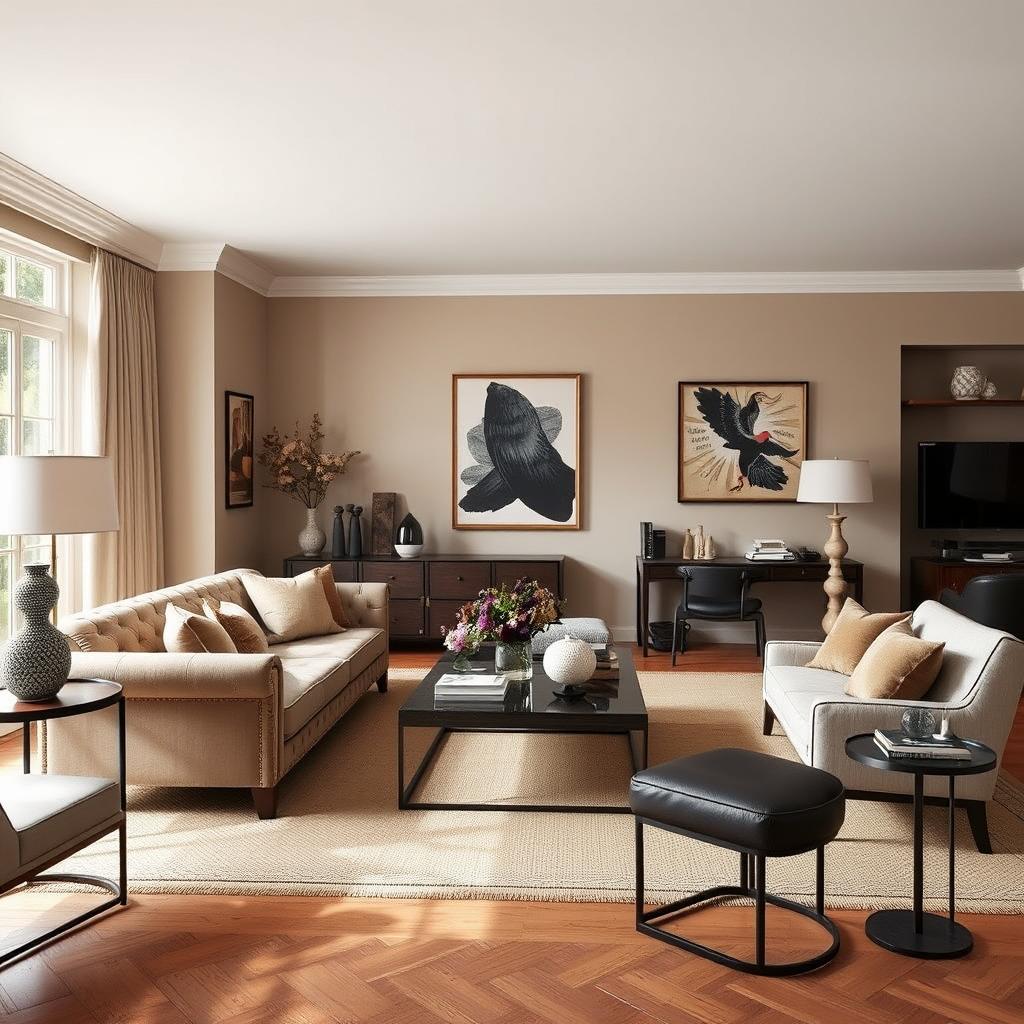
Furniture and Fixtures in Transition
Transitional design mixes the classic charm of traditional styles with the sleek look of modern design. This blend is seen in the furniture and fixtures that make up a transitional interior. Plush sofas and armchairs have clean lines and textured fabrics, making the space cozy yet elegant.
Wooden pieces, like shelving and coffee tables, show off the natural beauty of wood. Metal accents, such as lighting and hardware, bring a modern touch. These elements are placed thoughtfully to create a balanced space that combines old and new.
In transitional design, both practicality and comfort are key, making it perfect for families. Neutral colors like taupe, ivory, and gray provide a calm background. Bold colors add depth and interest.
Lighting fixtures in transitional design are often modern, acting as highlights that brighten the area. Window treatments, such as sheer and velvet drapes, enhance the look by adding texture and style.
Transitional design is all about mixing different features, like curves and straight lines, for a timeless look. This approach lets homeowners add personal touches, like family heirlooms or art, to make the space truly their own.
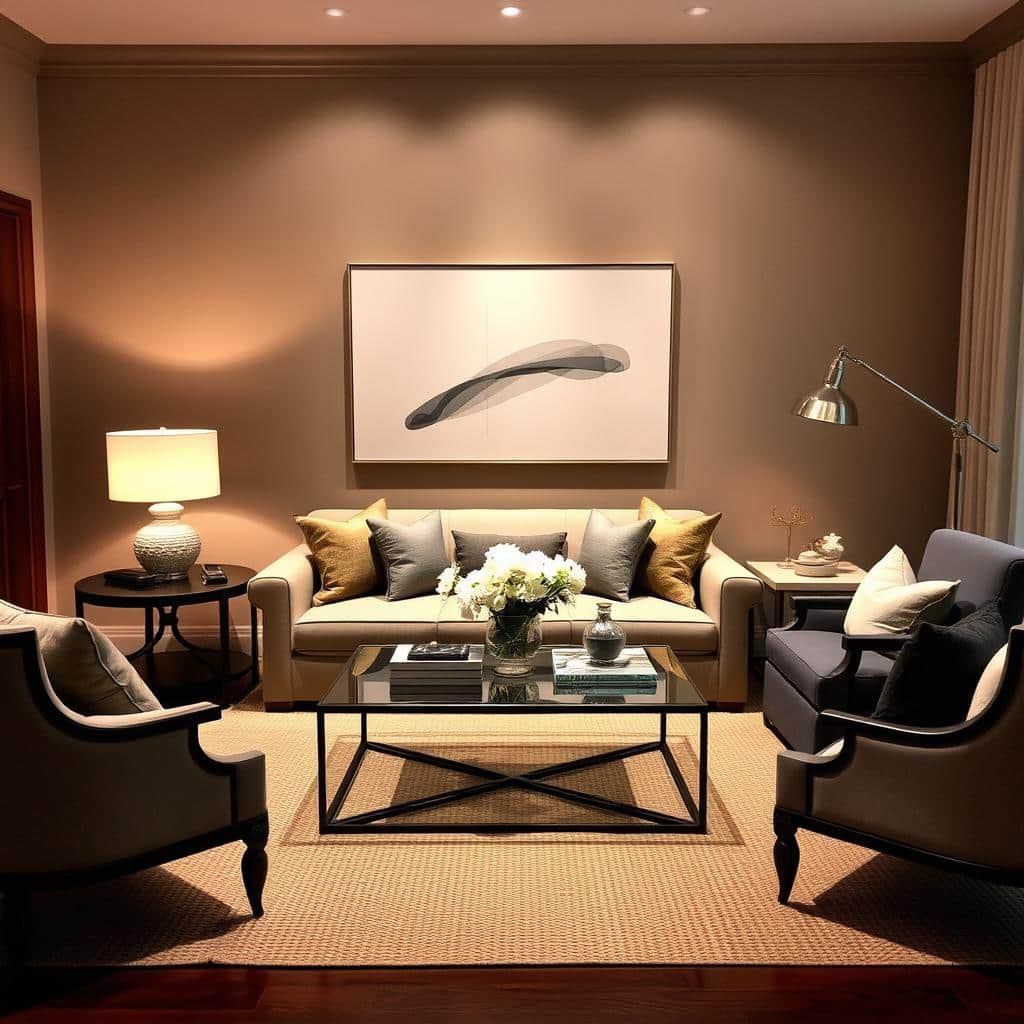
Textural Contrast and Depth
Transitional interior design focuses on mixing different textures and depths. It uses various materials and finishes to make spaces interesting and inviting. Solids and subtle patterns are the base, but it also adds unique elements and modern trends for personality and style.
Solids, Patterns, and Symmetry
Textiles like velvet and linen add depth. Wood and metal accents bring a mix of old and new. The core colors are soft and neutral, like tan, cream, and gray. Rich greens, blues, and browns are used for highlights.
Incorporating Modern Trends
Transitional design stays modern with clean lines and slightly curved furniture. It creates a calm and welcoming feel. Adding cozy elements with organic materials makes the space comfortable and stylish. This blend of old and new makes examples of transition in interior design timeless and adaptable.
| Texture Usage | Furniture Lines and Curves | Accessories and Comfort |
|---|---|---|
|
|
|
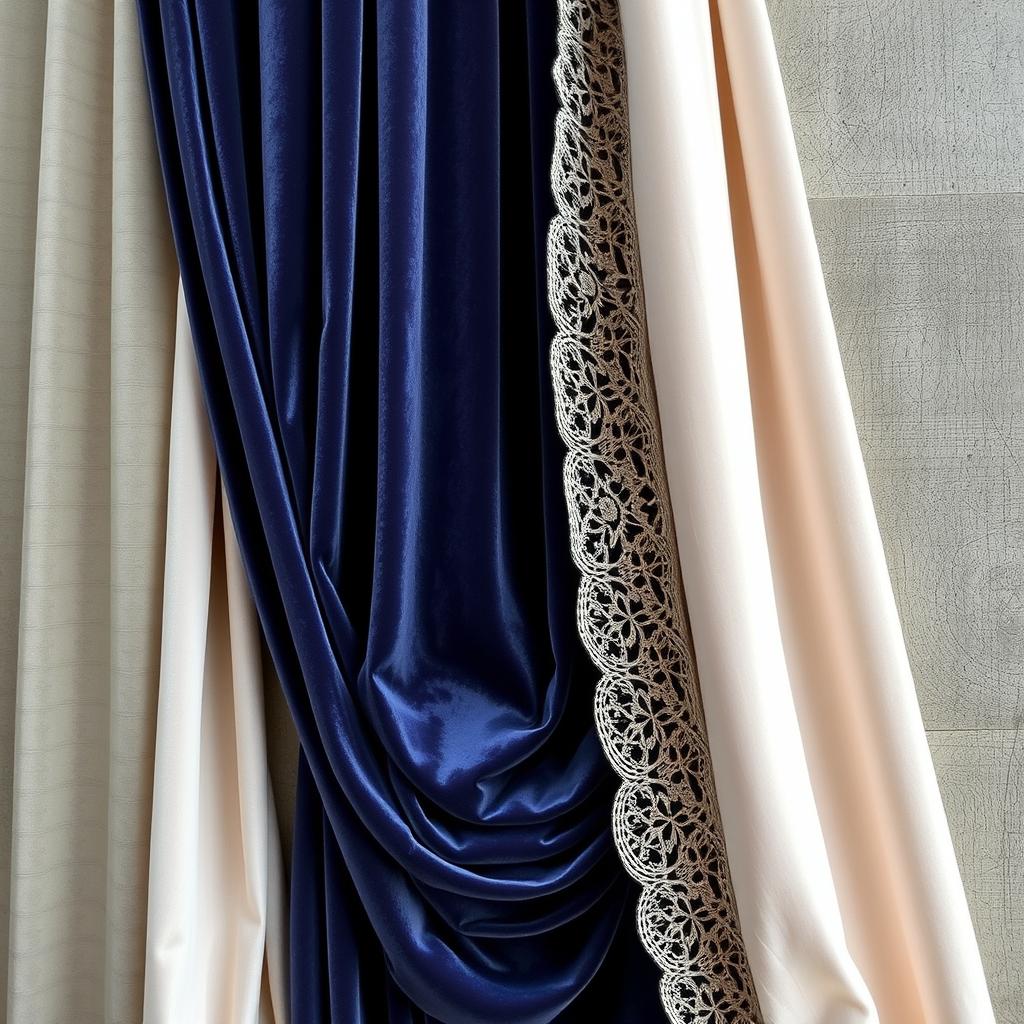
Transitional Kitchen Design
Transitional kitchen design mixes the warmth of traditional styles with the simplicity of modern ones. It often uses a neutral color scheme. This includes cabinetry in soft colors paired with modern hardware.
Countertops might combine natural stone with subtle patterns. Backsplashes add texture with tile or stone. Lighting, like pendant lights, brings a modern touch to the space.
A study by the National Kitchen and Bath Association (NKBA) shows transitional kitchens are the top choice. White kitchens are the favorite, followed by neutral colors like gray and beige. Wood tones and blues are also common.
These kitchens focus on keeping things tidy with smart storage. Painted wood or woodgrain cabinets with recessed doors are popular. Quartz or quartzite countertops add a sleek look. Stainless steel appliances and pendant lights complete the modern feel.
Transitional kitchen design is becoming more popular in interior design. It combines old and new, creating a timeless look. This style suits many homeowners, making kitchens both harmonious and welcoming.
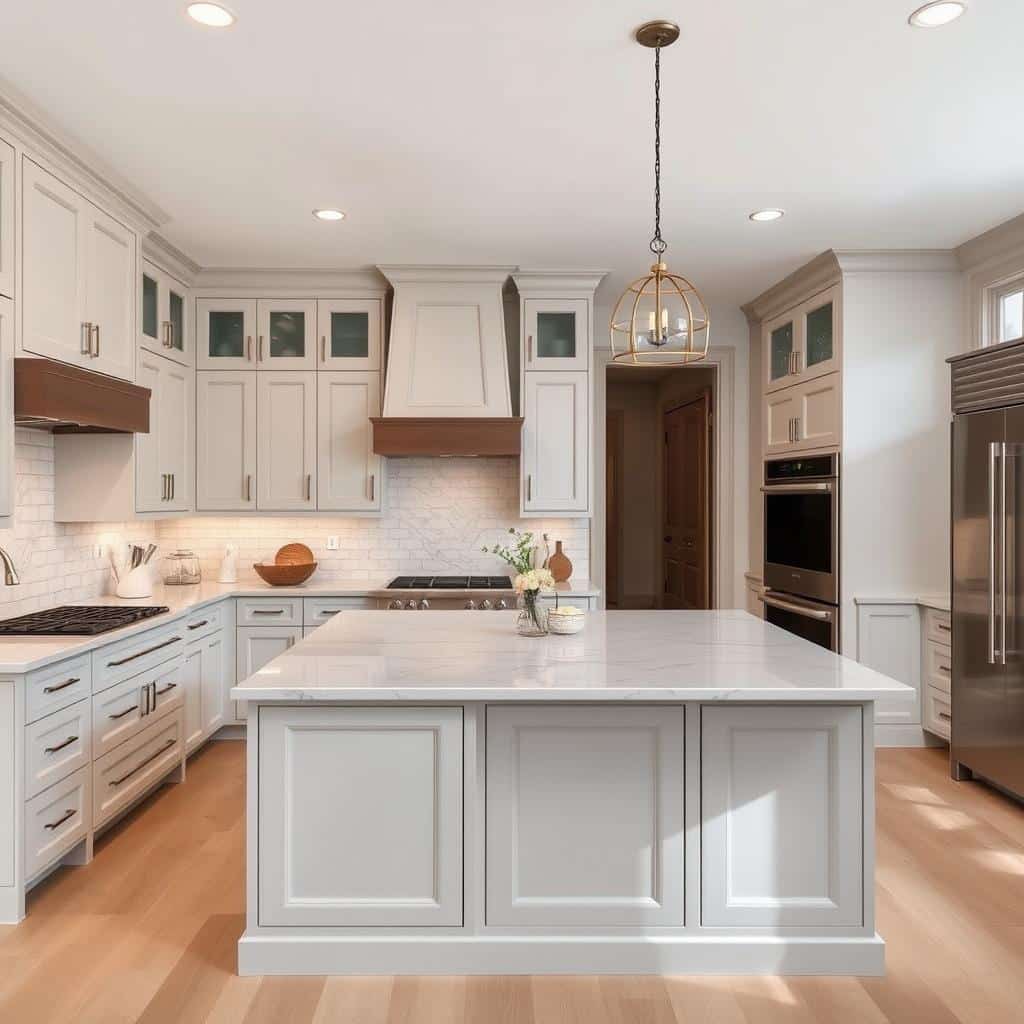
Tone and Warmth in Spaces
Transitional interior design is known for making spaces warm and inviting. It blends traditional and modern elements for a perfect balance. This design uses neutral colors, natural materials, and textures to create a cozy yet elegant feel.
At its core, transitional design focuses on making spaces timeless and comfortable. Designers pick furniture, finishes, and accents with care. This way, they create a space that suits many tastes and feels welcoming.
Neutral colors like grays, whites, and beiges are key in transitional design. They provide a calm background for textures and accents. Natural materials add warmth, while modern pieces bring sophistication.
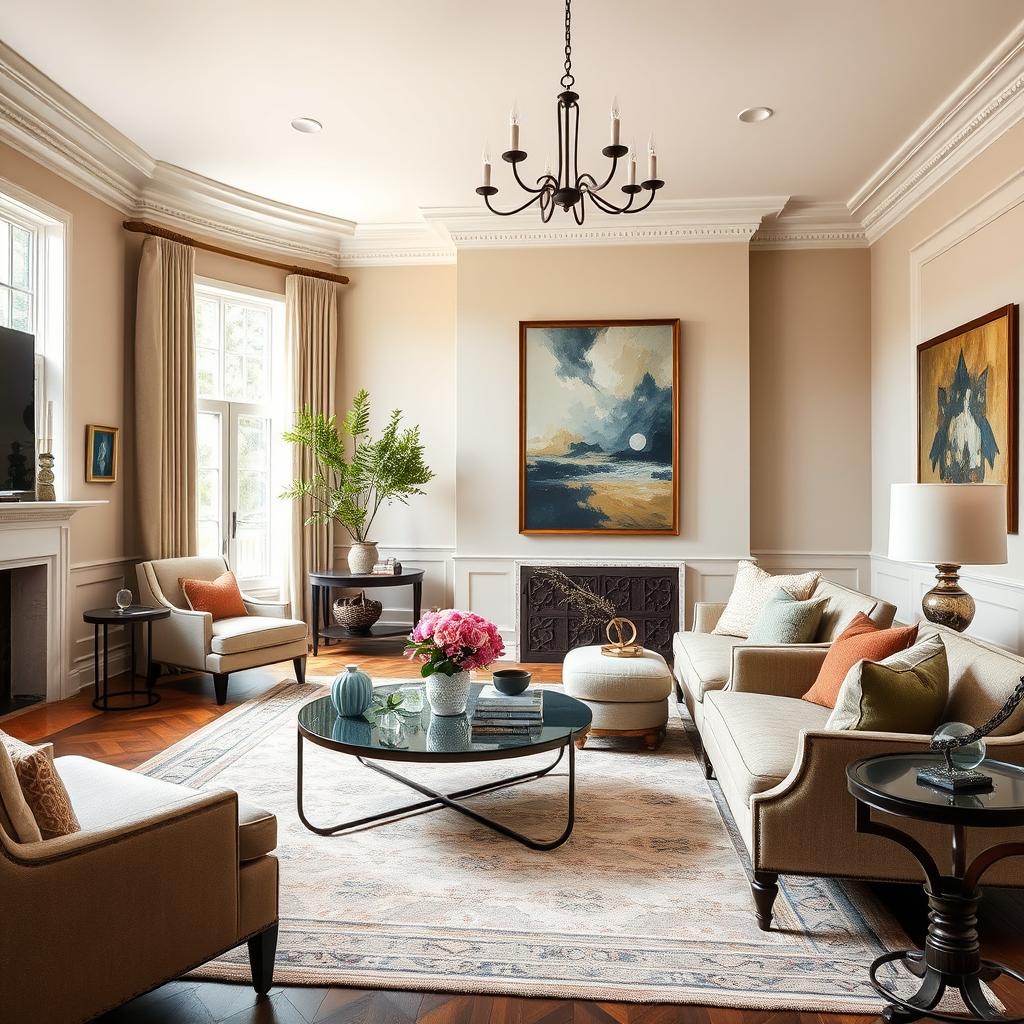
Transitional design balances old and new to make spaces feel both classic and modern. It turns any room into a cozy and inviting place. Whether it’s a living room transitional style interior design, bedroom, or kitchen, transitional design makes every space warm and welcoming.
Finding Your Interior Style
When looking at different interior design styles, think about what you like and how you live. Transitional style home is great because it mixes old and new in a way that works for many people.
Looking at transitional vs. traditional styles can help you choose. This way, you can make a home that looks good now and will for years to come, showing off your personal taste.
- Transitional design combines old and new for a look that’s both timeless and elegant.
- Transitional style homes use simple colors, clean lines, and mix old and new furniture and decor.
- Traditional design, by contrast, has fancy details, rich fabrics, and a formal, historic feel.
When thinking about transition interior design examples, think about the mood you want your space to have. Do you want it to feel cozy and welcoming or more formal and elegant? Knowing what you like and need will help you find the right mix of old and new.
The best thing about transitional design is how it can change to fit your taste and the latest trends. By choosing this flexible style, you can make a transitional style home that’s both classic and shows off your personality.
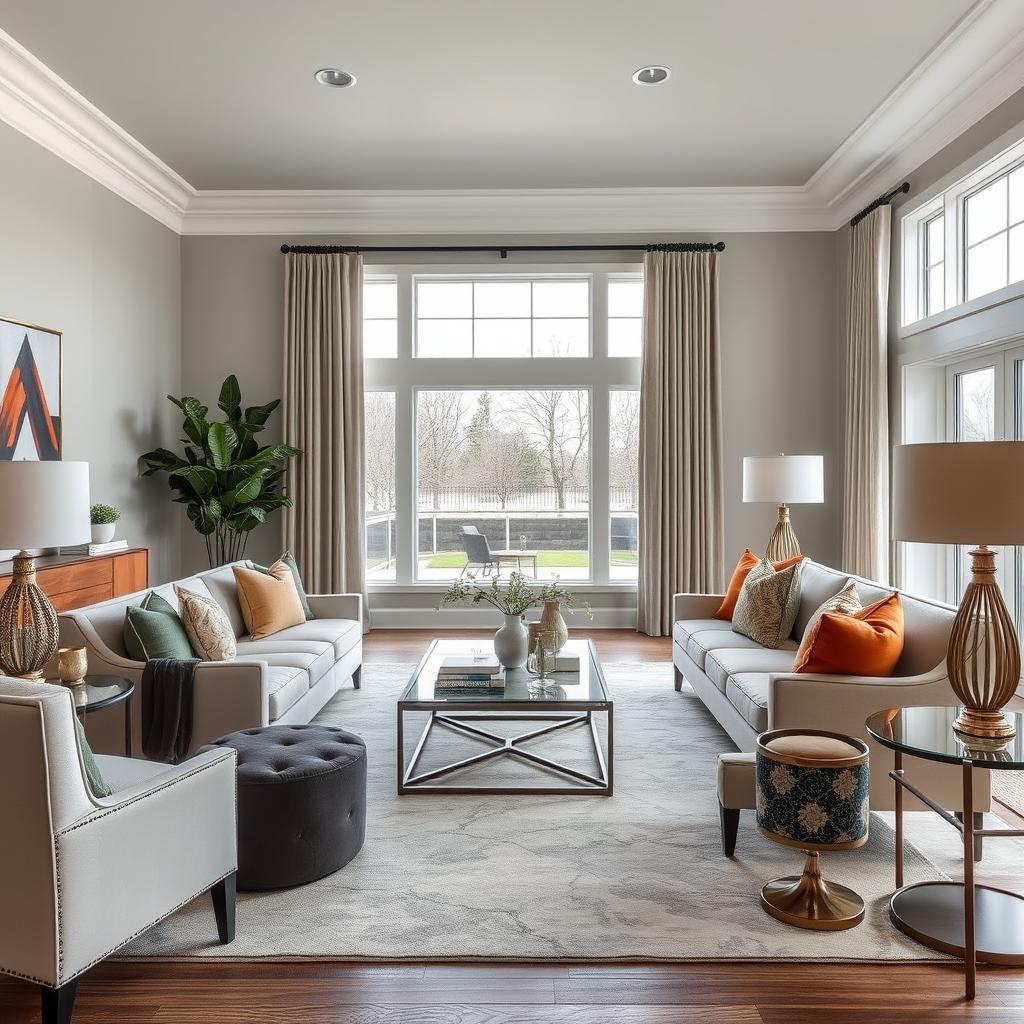
Conclusion: Embracing Timeless Transitional Design
Transitional interior design is a mix of classic and modern styles. It combines the warmth of old with the simplicity of new. This creates spaces that are both timeless and trendy.
This style focuses on balance and texture. It uses different materials in a way that looks good and feels comfortable. It makes homes look great and feel welcoming.
Transitional style changes with the times but stays true to itself. It lets homeowners show their unique style and way of life. It’s a mix of old and new that works well together.
It’s perfect for those who love traditional or modern decor. Transitional interior design lets you make your space your own.
The beauty of transitional design is that it lasts. It blends the old with the new in a way that works for everyone. It makes homes that are beautiful and personal.
FAQ
What is transitional style?
What is transitional style? Transitional interior design mixes the cozy feel of traditional decor with the simplicity of modern design. It creates a look that is both welcoming and stylish, appealing to many people.
What are the key characteristics of transitional design?
Transitional design uses a calm color scheme, lots of natural light, and elegant seating. It balances old and new styles. This mix of materials and textures makes a space both beautiful and cozy.
How does transitional design differ from traditional and contemporary styles?
Traditional design is rich and ornate, inspired by old Europe. Contemporary design is simple and modern. Transitional design combines these, creating a style that is both timeless and adaptable.
What role do furniture and fixtures play in transitional design?
In transitional design, furniture and fixtures are a mix of old and new. You’ll see plush sofas and wooden pieces that show off their natural beauty. Metal accents add a touch of modernity, making the space balanced and attractive.
How does transitional design use color and texture?
Transitional design favors a calm color scheme, often using beige, taupe, and grey. These colors bring a sense of peace. Adding different textures, like velvet and linen, adds depth and interest without overwhelming the space.
How can transitional design be applied to the kitchen?
Transitional kitchen design combines old and new, using a neutral color scheme and sleek cabinets. It also mixes natural stone with modern hardware. This creates a welcoming space that blends classic and modern styles.
How does transitional design achieve a sense of timeless elegance?
Transitional design balances traditional warmth with modern simplicity, creating a lasting elegance. Using neutral colors, natural materials, and textures makes the space both stylish and comfortable.
How can one determine if transitional design is the right fit for their personal style?
Choosing an interior design style should match your taste and lifestyle. Transitional design is versatile, fitting many tastes. It’s a great choice for those who want a mix of old and new.
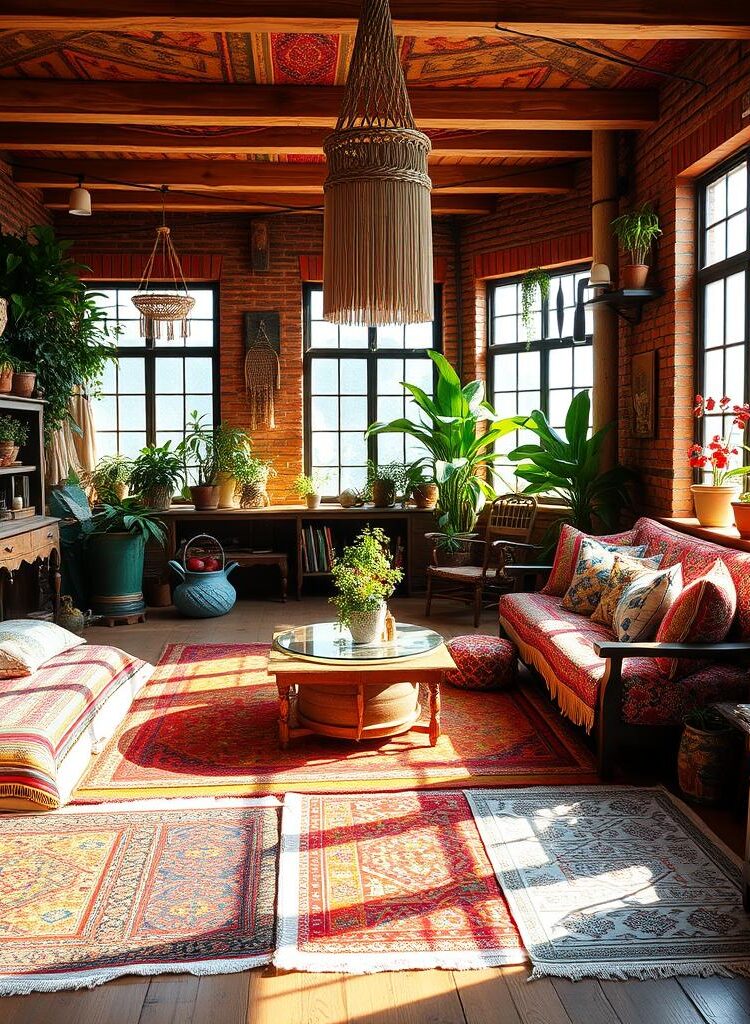
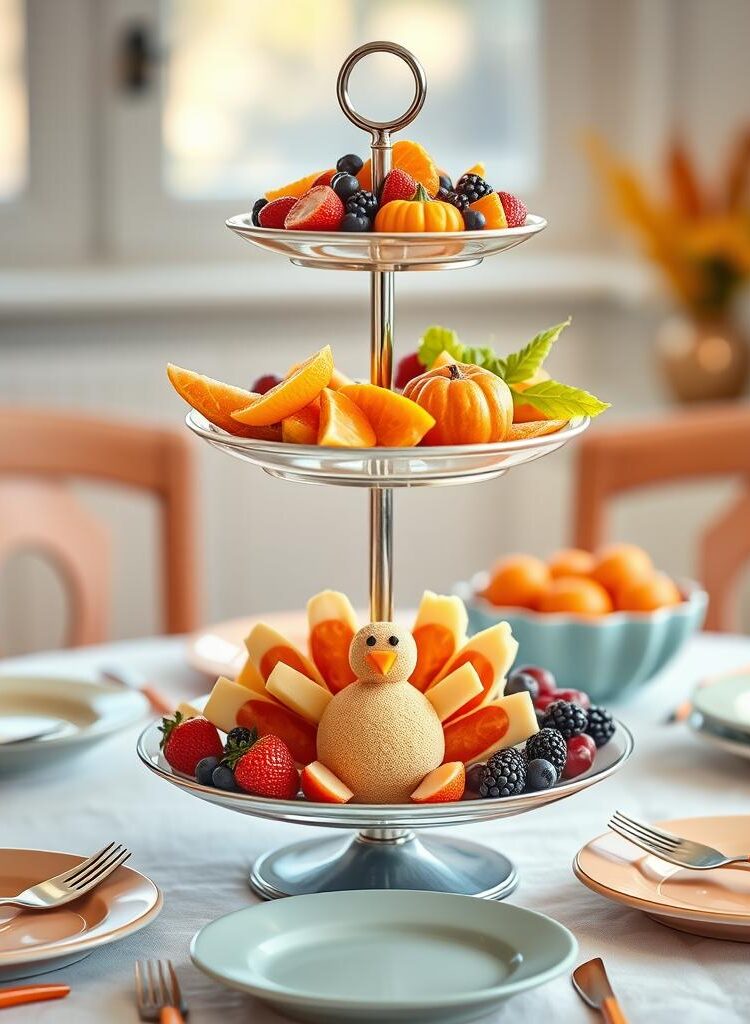
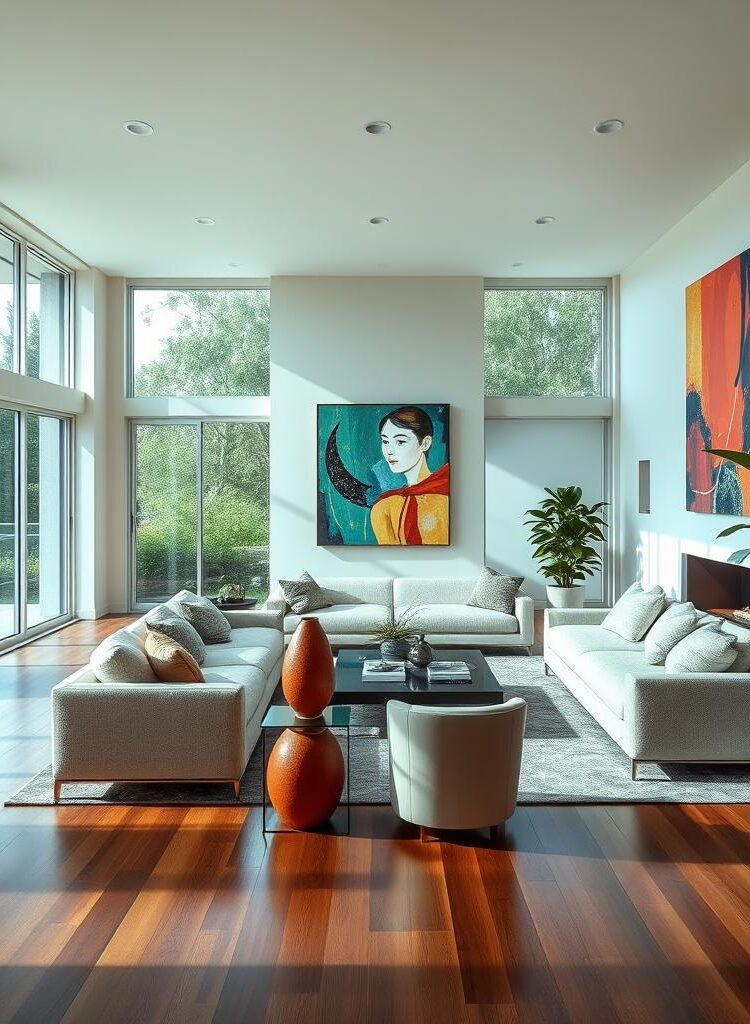
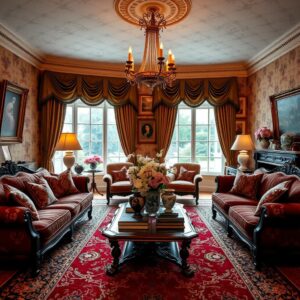
Leave a Reply